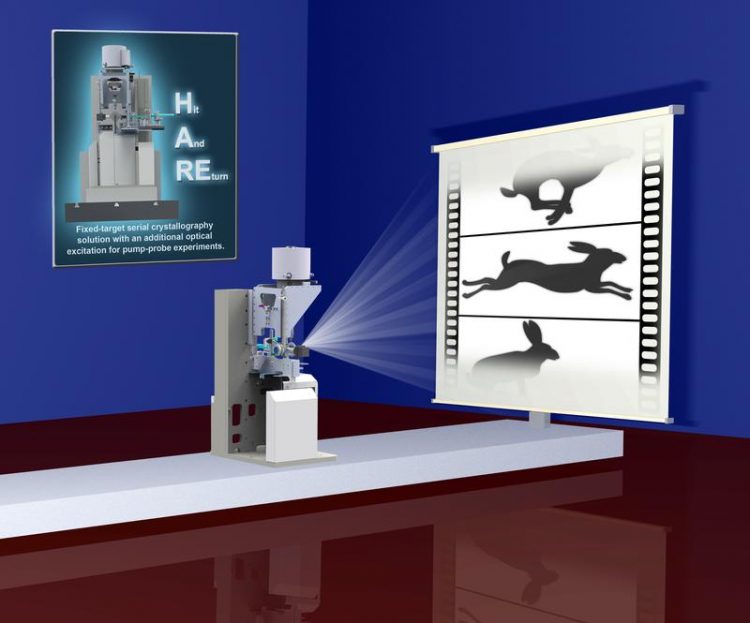Atomic view of nature's amazing molecular machines at work

The “hit and return” (HARE) method simplifies taking snap-shot movies of biomolecules at work. Jörg Harms / MPSD
This method not only simplifies the experiment but accelerates it so much that many snapshots can now be recorded in a single experimental session. These can then be assembled into a time-lapse sequence that shows the molecular foundations of biology.
All life is dynamic and so are its molecular building blocks. The motions and structural changes of biomolecules are fundamental to their function. However, understanding these dynamic motions at a molecular level is a formidable challenge.
One method to understand them is time-resolved X-ray crystallography, where the reaction of a biological molecule is triggered and then snapshots are taken as it reacts. However, these experiments are extremely time-consuming.
The new “hit-and-return” method is tailored to the study of biologically relevant reaction time-scales, which are on the order of milliseconds to seconds or even minutes. These time-scales are of particular interest to biologists and pharmaceutical researchers as they often reveal the structural changes relevant to a particular biological function or the turnover of a drug.
Combining the highly intense micro-focused X-ray beams available on beamline P14 of the European Molecular Biology Laboratory (EMBL) and beamline P11 at DESY (Deutsches Elektronen Synchrotron) with the hit and return method allowed the team to interrogate an important enzyme for the breakdown of manmade pollutants in action, on the millisecond time-scale.
Key to their success was that the “hit-and return” method makes the whole experiment a lot faster than previous approaches. While a single structural snapshot could previously only be obtained after several hours of data collection, the new “hit-and-return” method provides about 1 time-point per hour, irrespective of the delay-time.
The method works so well that it is now possible to collect many snapshots consecutively, letting the researchers record a time-lapse sequence of the structural changes during a biomolecule’s complete reaction within a single 24-hour experiment. Excitingly, this new method has great potential for existing and up-coming high-brilliance synchrotron radiation sources. Its far less time-consuming nature will allow many more researchers to carry out time-resolved crystallography studies.
Together with EMBL and the University of Hamburg, with the support of the German Department for Education and Research (BMBF), the “hit-and-return” method is already being implemented as a standard sample environment for the new time-resolved macromolecular crystallography end station on the EMBL beamline P14 at the PETRA III synchrotron at DESY.
The team anticipates that many more important insights about biochemical processes will come about by applying such cutting-edge technologies. A deeper understanding of these processes will, in turn, help to answer some of the most pressing questions about our health and the environment.
Dr Eike-Christian Schulz: eike.schulz@mpsd.mpg.de, tel. +49 40 8998 6264
Dr Pedram Mehrabi: pedram.mehrabi@mpsd.mpg.de
Media contact: jenny.witt@mpsd.mpg.de, tel +49 40 8998 6593
https://www.nature.com/articles/s41592-018-0180-2
http://www.mpsd.mpg.de/508372/2018-10-hare-schulz
https://news.embl.de/science/time-resolved-x-ray-crystallography/
Media Contact
All latest news from the category: Life Sciences and Chemistry
Articles and reports from the Life Sciences and chemistry area deal with applied and basic research into modern biology, chemistry and human medicine.
Valuable information can be found on a range of life sciences fields including bacteriology, biochemistry, bionics, bioinformatics, biophysics, biotechnology, genetics, geobotany, human biology, marine biology, microbiology, molecular biology, cellular biology, zoology, bioinorganic chemistry, microchemistry and environmental chemistry.
Newest articles

Properties of new materials for microchips
… can now be measured well. Reseachers of Delft University of Technology demonstrated measuring performance properties of ultrathin silicon membranes. Making ever smaller and more powerful chips requires new ultrathin…

Floating solar’s potential
… to support sustainable development by addressing climate, water, and energy goals holistically. A new study published this week in Nature Energy raises the potential for floating solar photovoltaics (FPV)…

Skyrmions move at record speeds
… a step towards the computing of the future. An international research team led by scientists from the CNRS1 has discovered that the magnetic nanobubbles2 known as skyrmions can be…





















